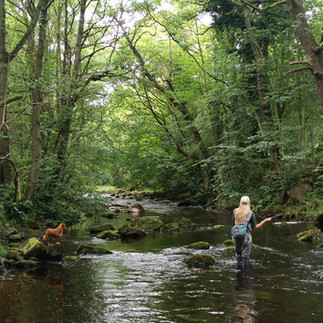Trout and Grayling Fishing on the River Ure: A Guide to the Swinton Estate
- northernfishingschool

- May 4
- 3 min read
The River Ure, flowing gracefully through the picturesque landscapes of North Yorkshire, offers a premier destination for trout and grayling fishing, particularly around the historic Swinton Estate near Masham. This area is renowned for its rich fishing opportunities, providing anglers with an idyllic setting to pursue these elusive fish across varying seasons.

The Swinton Estate Experience
The Swinton Estate boasts over four miles of fishing on the River Ure, along with additional opportunities on the River Burn. This extensive access allows anglers to explore diverse fishing environments, from tranquil pools to faster-flowing sections, each offering unique challenges and rewards.

Seasons for Trout and Grayling Fishing
Spring and Summer: As the waters warm, trout become more active, feeding on emerging insects. This is an ideal time to use dry flies such as the Parachute Adams or the Blue Winged Olive in sizes 14-18, mimicking the natural hatches.
Autumn: With the arrival of cooler temperatures, grayling fishing becomes particularly rewarding. Nymph patterns like the Pheasant Tail Nymph (PTN) and Hare's Ear Nymph in sizes 16-20 are effective, especially in deeper runs where grayling tend to hold.
Winter: While challenging, winter fishing can be productive for grayling. Focus on deeper pools using weighted nymphs or Czech nymphing techniques to reach fish in the colder, slower waters.
Modern European Shortline Nymphing

Modern European Shortline Nymphing is a highly effective technique for targeting trout and grayling in the River Ure's varied conditions. This method involves using a long, light rod to present nymphs with precision and sensitivity. The absence of a traditional fly line allows for direct contact with the nymphs, enhancing the detection of subtle takes. Anglers often employ a two-fly rig with flies like the French Nymph Jig, to efficiently cover different depths and currents. This technique excels in fast-flowing sections and offers unparalleled control, making it a favored choice for those seeking to maximize their catch.
Recommended Fly Patterns
1. Parachute Adams (Size 14-18): A versatile dry fly that imitates a variety of mayflies, effective during spring and summer hatches.
2. Pheasant Tail Nymph (Size 16-20): A staple for grayling, this nymph is effective year-round, particularly in autumn and winter.
3. Hare's Ear Nymph (Size 16-20): Known for its lifelike appearance, this nymph is excellent for both trout and grayling in varying conditions.
4. CDC Dun (Size 14-18): A delicate dry fly perfect for imitating emerging duns during spring and early summer, especially in calm waters.
5. French Nymph Jig (Size 14-18): This jigged nymph is highly effective in fast currents and deeper runs, making it ideal for targeting grayling and trout throughout the year.
6. Articulated Streamer (Size 4-8): Perfect for attracting larger trout, this streamer mimics small fish and is best used in deeper pools and faster water sections.

Fishing Opportunities with Northern Fishing School
The Northern Fishing School, based on the Swinton Estate, offers a range of fishing experiences:
Day Tickets: Enjoy a day of fishing for trout and grayling with convenient day ticket options.
Guided Sessions: Benefit from expert guidance with personalized fishing sessions tailored to your target species and skill level.
Syndicate Membership: For those seeking a more committed fishing experience, the Swinton Estate offers syndicate memberships, providing access to exclusive fishing spots and a community of fellow enthusiasts.

Fishing on the River Ure around the Swinton Estate offers a unique blend of natural beauty and exceptional angling opportunities. Whether you're targeting trout in the vibrant spring months or pursuing grayling in the crisp autumn air, the Swinton Estate provides an idyllic setting for your fishing adventures. For more information or to plan your visit, contact the Northern Fishing School and discover the rich fishing heritage of North Yorkshire.





































Comments